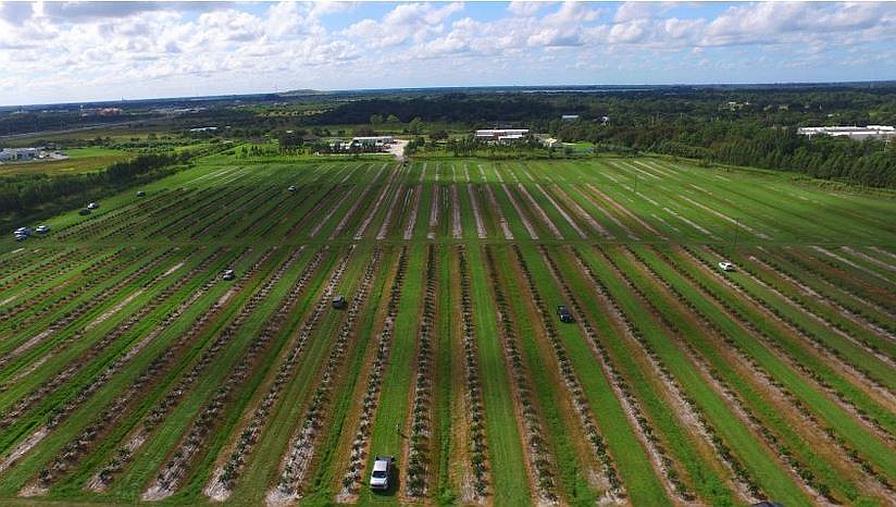Holding Out Hope: 2 Florida Citrus Variety Experiments Growing Well

Hope is growing amid the varieties being tracked in two experimental citrus research projects in Florida. This one is a bird’s eye view of Millennium Block in Ft. Pierce.
Photo courtesy of UF/IFAS
Florida citrus growers are hungry for new hope — any hope — in the battle against HLB. Valuable research has been going on in two experimental groves that could provide something for stakeholders to grow on. Scientific data points from two active research projects, involving more than 39,000 trees, are aiming to reveal which new varieties will tolerate pressure from HLB. How is it going so far?
The first experimental citrus grove, the Millennium Block, includes 20 acres of grapefruit, grapefruit-hybrids, oranges, and mandarins. The more than 5,500 trees under study in the Millennium Block are entering fruit-bearing years. As the trees mature, they reveal differences in trunk size and foliage. Some trees hold a substantial amount of fruit. Other trees produce low or no fruit.
“Although trees in both experimental projects show differences in terms of disease tolerance and fruit quality and quantity, the oldest trees are only in the fourth year of growth, and we have had only one harvest from one grove,” says Ronald D. Cave, Director of the UF/IFAS Indian River Research and Education Center.
The second citrus experimental project is called “The MAC Project,” or the USDA Multi-Agency Coordination Project. The MAC project involves 42 blocks evaluating seven grapefruit varieties grown on six different rootstocks. Planted in 2019, the MAC Project groves include plantings managed by 16 commercial growers on their lands across the state.
Initial findings are helping find varieties that stand out.
“For The MAC project, it appears from the data collected so far that we can eliminate ‘Star Ruby’ from further evaluations,” says Mark Ritenour, UF/IFAS Professor of Horticulture.
Early research findings for the Millennium Block are proving fruitful as well. Trials 1 and 2 consist entirely of grapefruit or grapefruit-pummelo hybrid scions.
“For Trial 1 of the Millennium Block so far, we identified 18 out of 54 scion and rootstock combinations with the best internal quality for the 2022-2023 season,” Ritenour notes.
In trial 2, Ritenour says it is important to evaluate not only total fruit yield but the percentage of the fruit that does not show HLB symptoms because some plots produced decent overall fruit yield, but most of it was not ‘good fruit.’”
“While US-812 was the 7th greatest yielding rootstock from 25 varieties included in the study, only 19% of the fruit was good fruit,” Ritenour says.
Cave adds that just before the first fruit harvest began in the fall 2022, Hurricanes Ian and Nicole brought high winds across the Indian River area, resulting in early fruit drop. The impacts from these storms solidify the need for more data. More will come after the 2023, 2024, and 2025 season harvests.
So, how much data is needed to advance? Researchers agree that a full seven years of data collection and analysis will provide reliable findings that growers can use.









